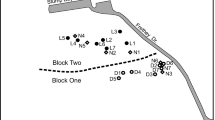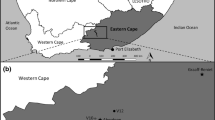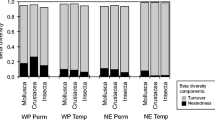Abstract
Impacts of co-occurring biotic and abiotic environmental variables on terrestrial mollusc communities have rarely been studied. In wetlands, terrestrial molluscs can drown or become stranded by rising water levels and they are often prey for predaceous beetles and small mammals. I used coverboard traps over a three year period to study the biotic and abiotic gradients that may structure a wetland prairie terrestrial mollusc community in western Oregon, USA. A non-metric multidimensional scaling (NMDS) ordination indicated that shrews (Sorex vagrans) and predaceous beetles were the primary gradients associated with the terrestrial mollusc community. Snails were associated with the presence of shrews, slugs were allied with predaceous beetles, and the vectors representing the shrew and predaceous beetle gradients were opposed, suggesting that beetles preyed upon snails while the shrews consumed both beetles and slugs. These hypothesized predator-prey relationships among molluscs, shrews, and beetles coincide with studies of Sorex gut contents and predaceous carabid beetle life history. The mollusc community was not associated with the water cover gradient in the NMDS ordination, but small mammal burrows and predaceous beetles were found in greater abundance in unflooded mound habitats. This suggests that standing water may temporally concentrate both predators and prey in a shared unflooded environment during the rainy season. The high metabolic demands of shrews and an apparent preference for both beetle and molluscan prey suggest that shrews may exert a strong top-down effect on invertebrate communities.
Similar content being viewed by others
Literature Cited
Abramsky, Z., H. Alfia, M. Schachak, and S. Brand. 1990. Predation by rodents and the distribution and abundance of the snail Trochoidea seetzenii in the central Negev Desert of Israel. Oikos 59: 225–34.
Armsworth, C. G., D. A. Bohan, S. J. Powers, D. M. Glen, and W. O. C. Symondson. 2005. Behavioral responses by slugs to chemicals from a generalist predator. Animal Behaviour 69: 805–11.
Boag, D. A. 1982. Overcoming sampling bias in studies of terrestrial gastropods. Canadian Journal of Zoology 60: 1289–92.
Bohan, D. A., A. C. Bohan, D. A. Glen, W. O. C. Symondson, C. W. Wiltshire, and L. Hughes. 2000. Spatial dynamics of predation by carabid beetles on slugs. Journal of Animal Ecology 69: 367–79.
Bray, J. R. and J. T. Curtis. 1957. An ordination of the upland forest communities in southern Wisconsin. Ecological Monographs 27: 325–49.
Broadbooks, H. E. 1939. Food habits of the vagrant shrew. The Murrelet 20: 62–66.
Broza, M. and E. Nevo. 1994. Selective land snail predation by the spiny mouse, Acomys cahirinus, in Nahal Oren, Mt. Carmel, Israel. Israel Journal of Zoology 40: 173–76.
Burch, J. B. and T. A. Pearce. 1990. Terrestrial Gastropoda. p. 201–309. In D. L. Dindal (ed.) Soil Biology Guide. John Wiley & Sons, Inc., New York, NY, USA.
Castelli, R. M., J. C. Chambers, and R. J. Tausch. 2000. Soilplant relations along a soil-water gradient in great basin riparian meadows. Wetlands 20: 251–66.
Chase, J. M. 1998. Central-place forager effects on food web dynamics and spatial pattern in northern California meadows. Ecology 79: 1236–45.
Churchfield, S. 1982. Food availability and the diet of the common shrew, Sorex araneus, in Britain. Journal of Animal Ecology 51: 15–28.
Churchfield, S. 1993. Foraging strategies of shrews: interactions between small predators and their prey. Symposia of the Zoological Society of London 65: 235–52.
Churchfield, S., J. Hollier, and V. K. Brown. 1991. The effects of small mammal predators on grassland invertebrates, investigated by field exclosure experiment. Oikos 60: 283–90.
Clarke, K. R. 1993. Non-parametric multivariate analysis of changes in community structure. Australian Journal of Ecology 18: 117–43.
Collins, S. L. 2000. Disturbance frequency and community stability in native tallgrass prairie. The American Naturalist 155: 311–25.
Cook, A. 1980. Field studies of homing in the pulmonate slug Limax pseudoflavus (Evans). Journal of Molluscan Studies 46: 100–05.
Cook, A. 2001. Behavioural ecology: on doing the right thing, in the right place at the right time. p. 447–87. In G. M. Barker (ed.) The Biology of Terrestrial Molluscs. CABI Publishing, New York, NY, USA.
Davies, P. and C. J. Grimes. 1999. Small-scale spatial variation of pasture molluscan faunas within a relic watermeadow system at Wylye, Wiltshire, U.K. Journal of Biogeography 26: 1057–63.
DeVries, P. J. and T. R. Walla. 2001. Species diversity and community structure in neotropical fruit-feeding butterflies. Biological Journal of the Linnean Society 74: 1–15.
Eisenberg, J. F. 1964. Studies on the behavior of Sorex vagrans. The American Midland Naturalist 72: 417–25.
Ellyson, W. J. T. and S. C. Sillet. 2003. Epiphyte communities on sitka spruce in an old-growth redwood forest. The Bryologist 106: 197–211.
Evans, K. L., P. H. Warren, and K. J. Gaston. 2005. Speciesenergy relationships at the macroecological scale: a review of the mechanisms. Biological Reviews 80: 1–25.
Finke, D. L. and R. F. Denno. 2006. Spatial refuge from intraguild predation: implications for prey suppression and trophic cascades. Oecologia 149: 265–75.
Finley, K. F. 1995. Hydrology and related soil features of three Willamette Valley wetland prairies. M.S. Thesis. Oregon State University, Corvallis, OR, USA.
Haro, R. J., R. Gillis, and S. T. Cooper. 2004. First report of a terrestrial slug (Arion fasciatus) living in an aquatic habitat. Malacologia 45: 451–52.
Holt, E. A. and P. M. Severns. 2005. The effects of prescribed burning on wet prairie lichen communities. Natural Areas Journal 25: 130–36.
Hooven, E. F., R. F. Hoyer, and R. M. Storm. 1975. Notes on the vagrant shrew, Sorex vagrans, in the Willamette Valley of western Oregon. Northwest Science 49: 163–73.
Huston, M. 1979. A general hypothesis of species diversity. The American Naturalist 113: 81–101.
Kotowski, W. and R. van Diggelen. 2004. Light as an environmental filter in fen vegetation. Journal of Vegetation Science 15: 583–94.
Kruskal, J. B. 1964. Nonmetric multidimensional scaling: a numerical method. Psychometrika 29: 115–29.
Lefcort, H., F. Ben-Ami, and J. Heller. 2006. Terrestrial snails use predator-diet to assess danger. Journal of Ethology 24: 97–102.
Lytle, D. A. 2001. Disturbance regimes and life-history evolution. The American Naturalist 157: 525–36.
MacArthur, R. H. 1958. Population ecology of some warblers of northeastern coniferous forests. Ecology 39: 599–619.
Mather, P. M. 1976. Computational Methods of Multivariate Analysis in Physical Geography. John Wiley & Sons, Inc., London, UK.
McCune, B. 1993. Gradients in epiphyte biomass in three Pseudotsuga-Tsuga forests of different ages in western Oregon and Washington. The Bryologist 96: 405–11.
McCune, B. and J. B. Grace. 2002. Analysis of Ecological Communities. MJM Software Design, Gleneden Beach, OR, USA.
McCune, B. and M. J. Mefford. 1999. PC-ORD. Multivariate Analysis of Ecological Data, Version 4. MjM Software Design, Gleneden Beach, OR, USA.
McKemey, A. R., W. O. C. Symondson, D. M. Glen, and P. Brain. 2001. Effects of slug size on predation by Pterostichus melanirus (Coleoptera: Carabidae). Biocontrol Science and Technology 11: 81–91.
Nekola, J. C. and T. M. Smith. 1999. Terrestrial gastropod richness patterns in Wisconsin carbonate cliff communities. Malacologia 41: 253–69.
Oberholzer, F. and T. Frank. 2003. Predation by the carabid beetles Pterostichus melanarius and Poecilus cupreus on slugs and slug eggs. Biocontrol Science and Technology 13: 99–110.
Ochocińska, D. and J. R. E. Taylor. 2005. Living at the physiological limits: field and maximum metabolic rates of the common shrew (Sorex araneus). Physiological and Biochemical Zoology 78: 808–18.
Parmenter, R. R. and J. A. MacMahon. 1988. Factors influencing species composition and population sizes in a ground beetle community (Carabidae): predation by rodents. Oikos 52: 350–56.
Pearl, R. 1902. A curious habit of the slug Agriolimax. Michigan Academy of Sciences 3: 75–76.
Pernetta, J. C. 1976. Diets of the shrew Sorex araneus L. and Sorex minutus L. in Wytham grassland. Journal of Animal Ecology 45: 899–912.
Pilsbry, H. A. 1939. Land Mollusca of North America (north of Mexico). Academy of Natural Sciences of Philadelphia Monograph 3, 1(1): 1–573.
Pilsbry, H. A. 1940. Land Mollusca of North America (north of Mexico). Academy of Natural Sciences of Philadelphia Monograph 3, 1(2): 575–994.
Pilsbry, H. A. 1946. Land Mollusca of North America (north of Mexico). Academy of Natural Sciences of Philadelphia Monograph 3, 2(1): 1–520.
Pilsbry, H. A. 1948. Land Mollusca of North America (north of Mexico). Academy of Natural Sciences of Philadelphia Monograph 3, 2(2): 521–1113.
Ripple, W. J. and R. C. Beschta. 2006. Linking cougar decline, trophic cascade, and catastrophic regime shift in Zion National Park. Biological Conservation 133: 397–408.
Rollo, C. D. and D. M. Shibata. 1991. Resilience, robustness, and plasticity in a terrestrial slug, with particular reference to food quality. Canadian Journal of Zoology 69: 978–87.
Roth, B. and P. H. Pressley. 1986. Observations on the range and natural history of Monadenia setosa (Gastropoda: Pulmonata) in the Klamath Mountains, California, and the taxonomy of some related species. The Veliger 29: 169–82.
Rudge, M. R. 1968. The food of the common shrew Sorex araneus L. (Insectivora: Soricidae) in Britain. Journal of Animal Ecology 37: 565–81.
Schmitz, O. J., P. A. Hambäck, and A. P. Beckerman. 2000. Trophic cascades in terrestrial systems: a review of the effects of carnivore removal on plants. The American Naturalist 155: 141–53.
Schurbon, J. M. and J. E. Fauth. 2003. Effects of prescribed burning on amphibian diversity in a southeastern U.S. national forest. Conservation Biology 17: 1338–49.
Severns, P. M. 2005. Response of a terrestrial mollusc community to an autumn prescribed burn in a rare wetland prairie of western Oregon, USA. Journal of Molluscan Studies 71: 181–87.
Severns, P. M. 2006. Seasonality, habitat preference, and life history of some Willamette Valley wet prairie terrestrial molluscs in western Oregon, USA. The Veliger 48: 63–70.
Shvarts, E. A., N. V. Chernyshev, and I. Y. Popov. 1995. Do shrews have an impact on soil invertebrates in Eurasian forests? Ecoscience 4: 158–62.
South, A. 1965. Biology and ecology of Agriolimax reticulatus (Müll.) and other slugs: spatial distribution. Journal of Animal Ecology 34: 403–17.
Suominen, O., J. Niemelä, P. Marikainen, P. Niemelä, and I. Kojola. 2003. Impact of reindeer grazing on ground-dwelling Carabidae and Curculionidae assemblages in Lapland. Ecography 26: 503–13.
Symondson, W. O. C., D. Glen, A. R. Ives, C. J. Langdon, and C. W. Wiltshire. 2002. Dynamics of the relationship between a generalist predator and slugs over five years. Ecology 83: 137–47.
Terry, C. J. 1981. Habitat differentiation among three species of Sorex and Neurotrichus gibbsi in Washington. The American Midland Naturalist 106: 119–25.
Verts, B. J. and L. N. Carraway. 2000. Land Mammals of Oregon. University of California Press, Berkeley, CA, USA.
Ward-Booth, J. F. and G. B. J. Dussart. 2001. Consistency in hand-searching for snails. Journal of Molluscan Studies 67: 502–06.
Whitaker, J. O., Jr., and C. Maser. 1976. Food habits of five western Oregon shrews. Northwest Science 50: 102–07.
Wittaker, R. H. 1954. The ecology of serpentine soils. Ecology 35: 258–67.
Yom-Tov, Y. 1970. The effect of predation on population densities of some desert snails. Ecology 51: 907–11.
Author information
Authors and Affiliations
Rights and permissions
About this article
Cite this article
Severns, P.M. Does standing water and predator presence structure a wetland terrestrial mollusc community?. Wetlands 27, 964–971 (2007). https://doi.org/10.1672/0277-5212(2007)27[964:DSWAPP]2.0.CO;2
Received:
Accepted:
Issue Date:
DOI: https://doi.org/10.1672/0277-5212(2007)27[964:DSWAPP]2.0.CO;2




